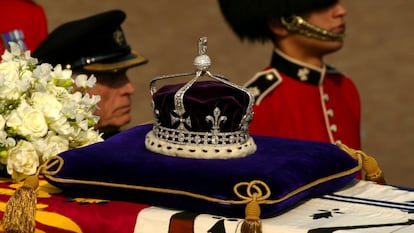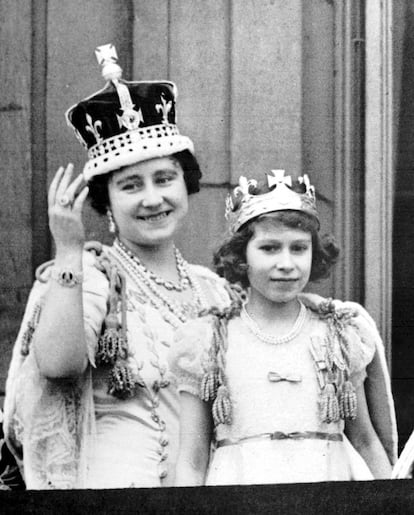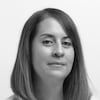India claims the Koh-i-Noor diamond, the jewel of Queen Elizabeth’s crown
An old international dispute reemerges between the Asian giant and the United Kingdom. One of the largest in the world, it is part of the piece that Camilla may wear to the coronation of Charles III

Koh-i-Noor, one of the largest diamonds in the world, which is set in the Crown of Queen Elizabeth, is once again the subject of controversy for the British royal family and its relationship with India. A spokesperson for the Indian prime minister Narendra Modi told The Telegraph this Wednesday that the use of the jewel evokes “painful memories of the colonial past.”
The announcement of the coronation of Charles III and queen consort Camilla, which will take place on May 6 in Westminster Abbey, has re-ignited the old dispute with the Asian giant about the Crown Jewels and their colonial origins. Buckingham Palace has expressed in a statement that the event will combine tradition and modernity. But, according to Indian authorities quoted in the Daily Mail, the announcement has led some in India to suggest that the use of the Koh-i-Noor jewel in the ceremony could “transport” some Indians to “the days of the British Empire.”
Though Charles III has inherited the jewels of Elizabeth II, who died this past September 8, he will not receive Queen Elizabeth’s crown in the coronation. According to tradition, the British monarch will receive the so-called St. Edward’s Crown which the British consider the most important and sacred piece, used only in coronations.
During the event, Camilla will also be crowned queen consort, but in a much simpler act. In this case, the queen consort will receive Queen Elizabeth’s crown, which contains the controversial Koh-i-Noor diamond.
The queen mother used the jewel in the ceremony of the opening of the British Parliament during the reign of her husband, King George VI. She also wore it during the coronation of her husband, in 1937, and her daughter, Elizabeth II, in 1953. As happened with the Imperial State Crown, which rested on the coffin of Elizabeth II during the state wake and funeral, Queen Elizabeth’s Crown with the Koh-i-Noor diamond rested on the coffin of the queen mother at her funeral and wake on April 5, 2002.

However, as a result of the controversy surrounding the diamond and its use in the coronation, sources close to the royal family insisted to the British newspaper The Telegraph that they have not decided whether or not to use Koh-i-Noor in the ceremony. In addition, the same sources said that the king and his team are “very aware” that times have changed and seek to prepare an event rooted in tradition, but taking into account “current problems” faced by Britons.
The cause of all this controversy, the Koh-i-Noor diamond —whose name means the Mountain of Light— belonged to Hindu, Mongolian, Persian and Afghan monarchs. In 1855 it passed into the hands of the British royal family, when Queen Victoria was named Empress of India and the last emperor of the Sikhs, Duleep Singh, who was then 10 years old, gave it to her. The stone is believed to originate from the Golconda mines in the state of Telangana in southeastern India. It carries a heavy curse for the males who have possessed it. According to a Hindu text from the 14th century, it is explained that whoever possesses this jewel “will dominate the world,” but will also “know all its misfortunes”: “Only God or a woman can wear it with impunity.”
India’s request to have this piece returned is not a recent issue. In 2010, then-British Prime Minister David Cameron addressed the matter in an interview on Indian television with statements that went around the world: “If you say yes to one you suddenly find the British Museum would be empty.”

In its defense, India assures that the diamond was not a gift. It argues that before being ordered to be cut by the Prince Consort Albert, the husband of Queen Victoria, it weighed 108 carats (the equivalent of 21.6 grams), and that the piece was stolen by the British royal family. These same accusations that now concern Charles III and the British monarchy intensified days after the death of Elizabeth II was announced, when the name of the jewel became a trending topic on social media with a clear message : “Return the jewel to India,” Saurav Dutt, a writer, Indian-born Englishman and political commentator, told the Daily Mail. “Such a position is at odds with the modern, egalitarian stance the Royals seek to present themselves within a world that seeks to move on from the ugliest chapters of history that they benefited from.” Without Buckingham having made any further comments on the matter, it will be necessary to wait until May 6, the day of the coronation of Charles III, to find out if the Koh-i-Noor diamond will again shine on the head of a queen, or whether it may even return to India.
Tu suscripción se está usando en otro dispositivo
¿Quieres añadir otro usuario a tu suscripción?
Si continúas leyendo en este dispositivo, no se podrá leer en el otro.
FlechaTu suscripción se está usando en otro dispositivo y solo puedes acceder a EL PAÍS desde un dispositivo a la vez.
Si quieres compartir tu cuenta, cambia tu suscripción a la modalidad Premium, así podrás añadir otro usuario. Cada uno accederá con su propia cuenta de email, lo que os permitirá personalizar vuestra experiencia en EL PAÍS.
¿Tienes una suscripción de empresa? Accede aquí para contratar más cuentas.
En el caso de no saber quién está usando tu cuenta, te recomendamos cambiar tu contraseña aquí.
Si decides continuar compartiendo tu cuenta, este mensaje se mostrará en tu dispositivo y en el de la otra persona que está usando tu cuenta de forma indefinida, afectando a tu experiencia de lectura. Puedes consultar aquí los términos y condiciones de la suscripción digital.
More information
Últimas noticias
A hybrid building: Soccer pitch, housing, and a shopping mall
Europe urges Trump to respect Greenland following annexation threats
Science seeks keys to human longevity in the genetic mixing of Brazilian supercentenarians
Luisa Neubauer, climate change activist: ‘Ecology shouldn’t be a punitive force, but a joyful and liberating one’
Most viewed
- Alain Aspect, Nobel laureate in physics: ‘Einstein was so smart that he would have had to recognize quantum entanglement’
- Mexico’s missing people crisis casts a shadow over World Cup venue
- Alvin Hellerstein, a 92-year-old judge appointed by Bill Clinton, to preside over Maduro’s trial in New York
- Why oil has been at the center of Venezuela-US conflicts for decades
- Cuba confirms death of 32 of its citizens in the US attack against Venezuela











































